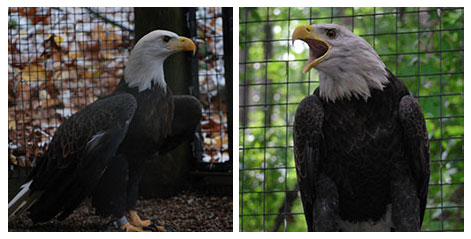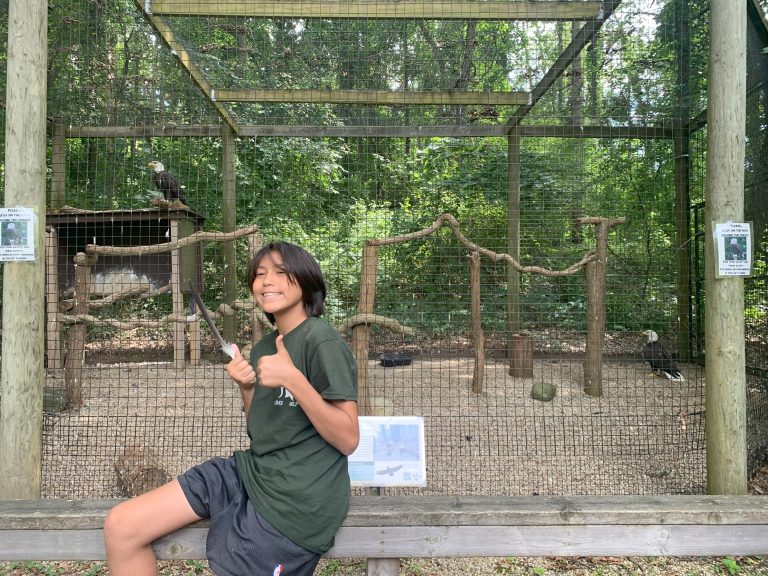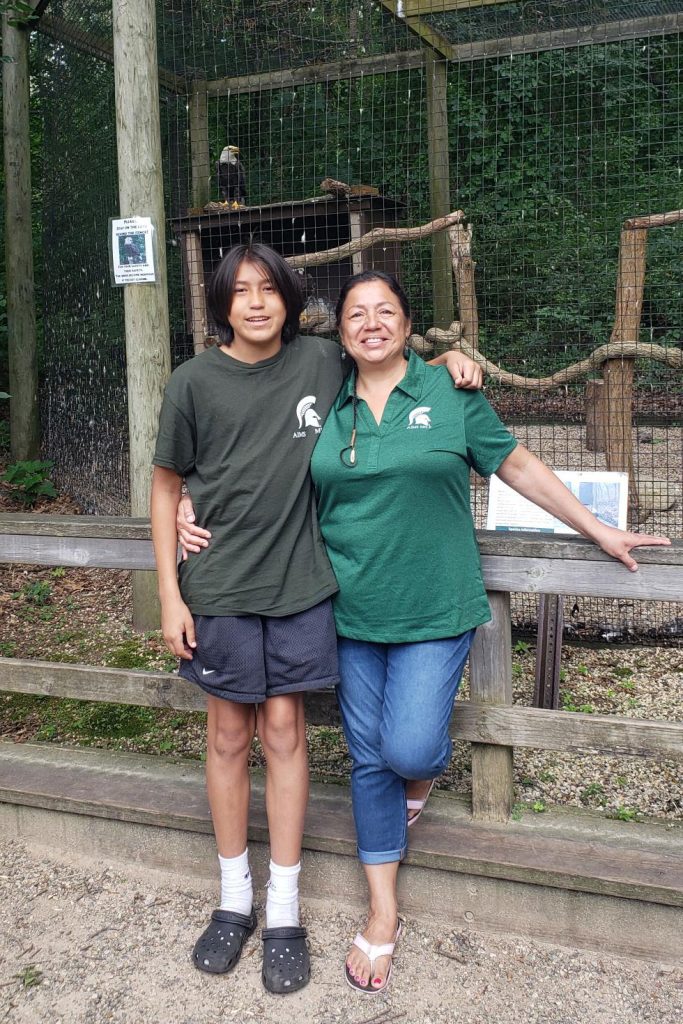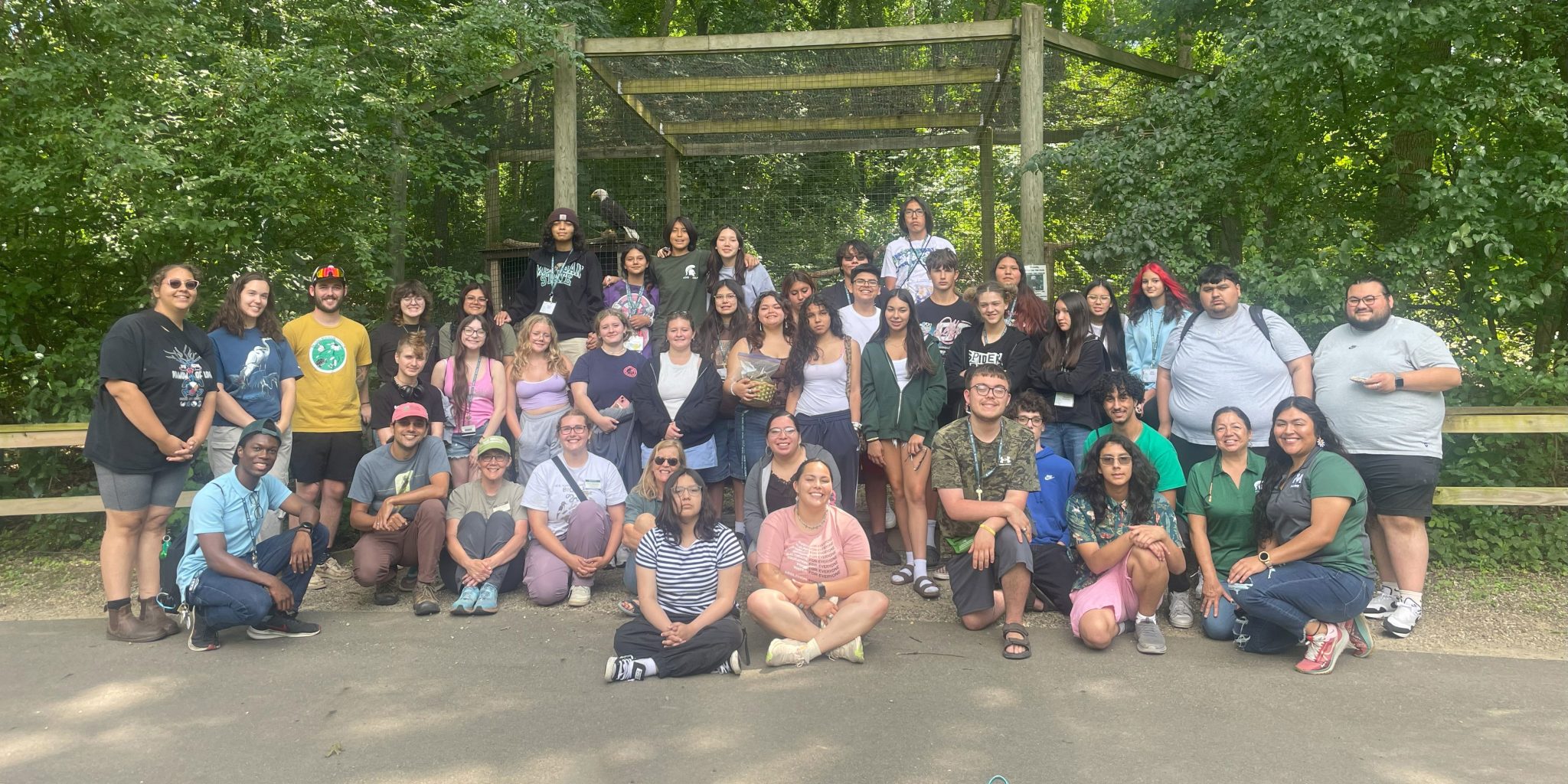The two bald eagles that reside at the W.K. Kellogg Bird Sanctuary recently were honored with new names, chosen collaboratively by Native American students participating in the 2024 Michigan Indian Leadership Program.
The new names, Nimikii (Thunder) and Waasimowin (Lightning), were celebrated during a naming ceremony held at the Sanctuary on Thursday, July 18.
The eagles, previously called Liberty and Patriot, respectively, both came to the sanctuary as juveniles. Nimikii (previously Liberty) was hatched in 2016, and Waasimowin (previously Patriot) was hatched in 2015, and each sustained an injury that rendered them unable to be released into the wild after recovery.
Indigenous roots in the lands of KBS
Long before W.K. Kellogg — and then Michigan State University — served as stewards of the land now known as the W.K. Kellogg Biological Station, which includes the Kellogg Bird Sanctuary, several native tribes lived on and cared for the land. The largest of those tribes were the Ojibwe (known by non-native people as Chippewa), Odawa (Ottawa) and Bodéwadmi (Potawatomi), sometimes referred to collectively as Anishinaabe, which roughly translates to “original people.”
The idea of bestowing Anishinaabe names on the sanctuary eagles was sparked in 2023 by that summer’s visitor experience intern, Ada Varga. Ada led tours of the Sanctuary as part of her internship and offered insights to visitors about the birds they saw — the wild birds as well as the birds that reside at the Sanctuary due to injury.
Ada educated sanctuary staff about the significance of eagles in Anishinaabe culture while leading a tour for the 2023 MILP students, inspiring KBS community outreach coordinator Misty Klotz to reach out to Stephanie Chau, assistant director for undergraduate diversity and MILP program coordinator, to talk about choosing more culturally important names for the sanctuary eagles. Together, they created a plan to choose new names, formally marking the change during the MILP’s 2024 tour of the Sanctuary.
The naming and ceremony
In preparing to choose the new names, MILP students were presented cultural teachings of the Eagle during their weeklong program by Anishnaabek elders. Program staff then held a brainstorming session, taking time to consider all the name suggestions. Later in the week, the program students voted on the names they liked best. Nimikii and Waasimowin were the names most preferred by the students.
On July 18, the MILP program visited the sanctuary for its annual tour. The group set out for a walk around the sanctuary’s Paved Path, eventually arriving at the eagle enclosure. Students brought sema (tobacco), kiishig (cedar), mshkwadewashk (sage) and wiingash (sweetgrass) with them to use in the ceremony. According to Klotz, when the group arrived the eagles were active and moving about their space, and one eagle released a feather.
After gathering in a circle, Brenden Kokx, the Sanctuary’s avian caretaker, talked about the eagles’ history before and after coming to the Sanctuary, and described their behaviors and personalities as he observes them. Students shared some of the teachings they had learned from the Anishinaabek elders earlier in the week. Cassius Caldwell, a MILP student who had proposed the names Nimikii and Waasimowin, shared the names that were selected and explained their Anishinaabek meaning and significance.
During the ceremony, participants said each name in unison once, holding tobacco in their left hands in each of the four directions, then offered tobacco to each of the eagles. The feather dropped by one of the eagles also was used in the ceremony. Before the naming ceremony began, the group also did a smudging, or purification, ceremony, burning the sage that the students had brought.
An experience ‘filled with gratitude and joy’
In addition to Caldwell, Chau, Klotz and Kokx, other KBS and Sanctuary staff and students attended the ceremony, as well as additional MILP participants and staff, including Jasmine Cabarrubia, Natali Gonzalez, Charles Grace, Ahmad Hassan, Sofia King, Nevaeh Marshall, Adon Vazquez and Ayebah Wilson. Several attendees reflected on how profoundly the ceremony affected them.
“It was one of the most culturally significant and emotional experiences in our program’s history,” Chau said of the ceremony.
“It is difficult to describe the joy we felt during this renaming ceremony,” added Klotz. “All I can say is that our hearts were filled with gratitude and joy.”
“Being part of the naming ceremony for a being so sacred and cherished was an honor that made the experience truly unforgettable,” said Gonzalez.
“It was an honor as native youth to be given that opportunity. It was a moment where everyone was connected,” said King.
The significance of eagles in Anishinaabe culture
To Anishinaabe people, the eagle (Migizi) is one of most revered and respected beings in creation. Eagles represent the link of the people to the Creator (Gchi Manidoo) and their connection to all that is spiritual. Anishinaabe teachings say when people lay down their tobacco (sema) offerings, Migizi comes down to gather their prayers and then soars high up to bring them to the Gchi Manidoo. Migizi connects the physical and spiritual worlds.
About the Michigan Indian Leadership Program
The Michigan Indian Leadership Program is a weeklong, indigenized summer experience co-sponsored by MSU’s College of Agriculture and Natural Resources and the Office of the Associate Provost for Undergraduate Education.
MILP is designed for Native American youth and other students with a strong interest and involvement in Native American culture and community. The program gives students in grades 7-11 the opportunity to learn about college, experience college life on a university campus, and explore the many exciting educational opportunities available in agriculture, food sciences, natural resources and related fields. The 2024 cohort of MILP participants came from all across the Great Lakes area, including Suttons Bay, Portage, Dearborn, Lake Orion, Holton, Grand Haven, Southgate, Lansing, Mt. Pleasant, Fowlerville and Commerce Township.
This story originally appeared on the Kellogg Bird Sanctuary website.




